Nursing Assignment: Ipratropium Bromide Use in COPD Case Study
VerifiedAdded on 2023/04/25
|9
|1932
|151
Case Study
AI Summary
This nursing assignment presents a case study of a 64-year-old patient, Jack, admitted with severe breathlessness due to COPD. The assignment details the administration of Ipratropium Bromide, including dosage, frequency, and route, emphasizing the importance of immediate relief and careful monitoring for contraindications and side effects. It discusses the nursing professional's role in providing immediate care, patient education, and preventive measures. The assignment also covers relevant medical interventions, such as managing blood pressure and anxiety, and adherence to National Safety and Quality Standards. The reflection highlights the clinical experience gained in managing COPD patients and applying medication knowledge, showcasing the learning process and improved ability to provide effective care in future situations. Desklib offers access to similar case studies and solved assignments for students.

Running head: NURSING ASSIGNMENT
IPRATROPIUM BROMIDE AND COPD CASE STUDY
Name of the study
Name of the university
Author note
IPRATROPIUM BROMIDE AND COPD CASE STUDY
Name of the study
Name of the university
Author note
Paraphrase This Document
Need a fresh take? Get an instant paraphrase of this document with our AI Paraphraser
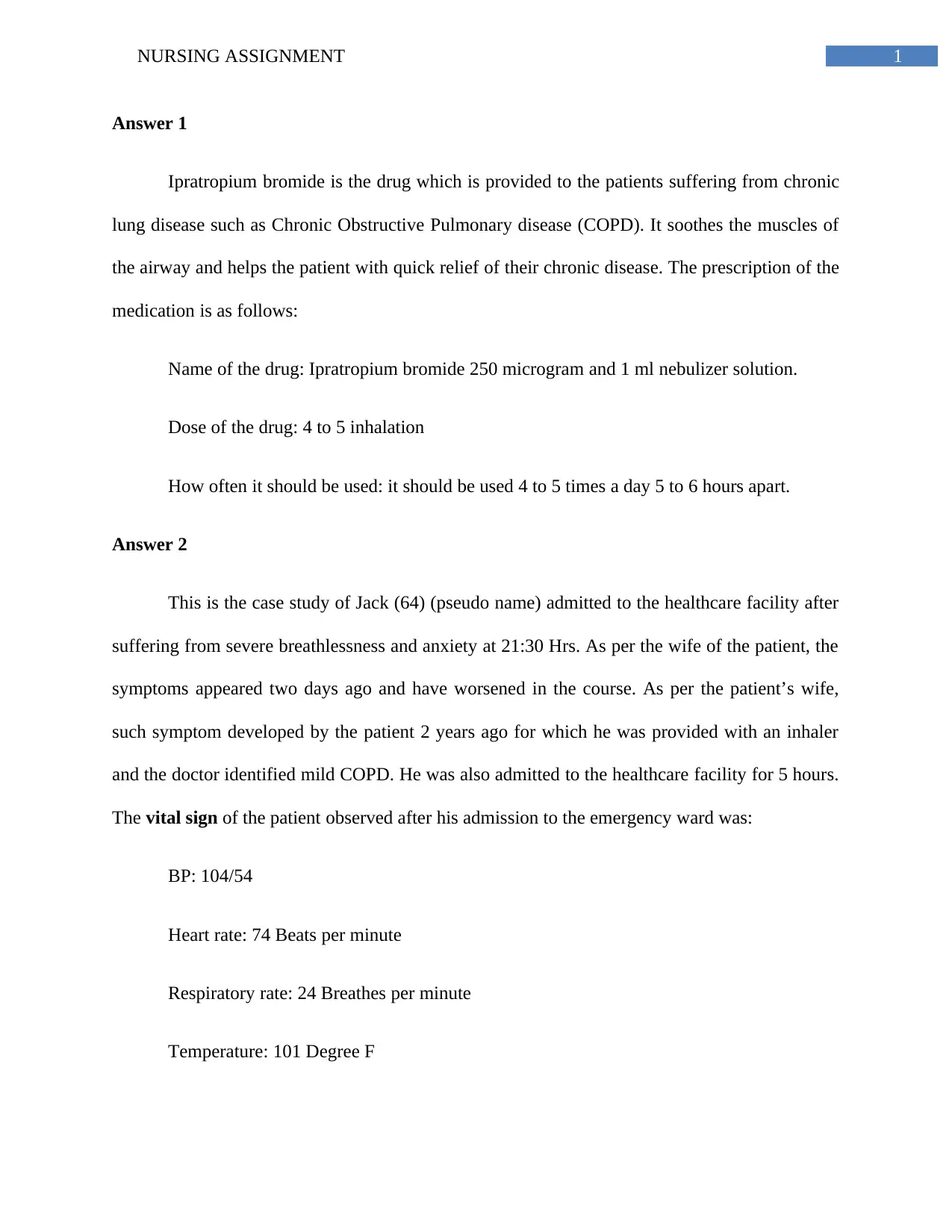
1NURSING ASSIGNMENT
Answer 1
Ipratropium bromide is the drug which is provided to the patients suffering from chronic
lung disease such as Chronic Obstructive Pulmonary disease (COPD). It soothes the muscles of
the airway and helps the patient with quick relief of their chronic disease. The prescription of the
medication is as follows:
Name of the drug: Ipratropium bromide 250 microgram and 1 ml nebulizer solution.
Dose of the drug: 4 to 5 inhalation
How often it should be used: it should be used 4 to 5 times a day 5 to 6 hours apart.
Answer 2
This is the case study of Jack (64) (pseudo name) admitted to the healthcare facility after
suffering from severe breathlessness and anxiety at 21:30 Hrs. As per the wife of the patient, the
symptoms appeared two days ago and have worsened in the course. As per the patient’s wife,
such symptom developed by the patient 2 years ago for which he was provided with an inhaler
and the doctor identified mild COPD. He was also admitted to the healthcare facility for 5 hours.
The vital sign of the patient observed after his admission to the emergency ward was:
BP: 104/54
Heart rate: 74 Beats per minute
Respiratory rate: 24 Breathes per minute
Temperature: 101 Degree F
Answer 1
Ipratropium bromide is the drug which is provided to the patients suffering from chronic
lung disease such as Chronic Obstructive Pulmonary disease (COPD). It soothes the muscles of
the airway and helps the patient with quick relief of their chronic disease. The prescription of the
medication is as follows:
Name of the drug: Ipratropium bromide 250 microgram and 1 ml nebulizer solution.
Dose of the drug: 4 to 5 inhalation
How often it should be used: it should be used 4 to 5 times a day 5 to 6 hours apart.
Answer 2
This is the case study of Jack (64) (pseudo name) admitted to the healthcare facility after
suffering from severe breathlessness and anxiety at 21:30 Hrs. As per the wife of the patient, the
symptoms appeared two days ago and have worsened in the course. As per the patient’s wife,
such symptom developed by the patient 2 years ago for which he was provided with an inhaler
and the doctor identified mild COPD. He was also admitted to the healthcare facility for 5 hours.
The vital sign of the patient observed after his admission to the emergency ward was:
BP: 104/54
Heart rate: 74 Beats per minute
Respiratory rate: 24 Breathes per minute
Temperature: 101 Degree F

2NURSING ASSIGNMENT
BMI: 41
Oxygen saturation level: 90% in room air
The physical assessment conducted mentioned that the skin was pale and dry, and his
abdomen showed no tenderness and was soft due to his obesity. Moist mucus membrane and
normal pupils were observed. After conducting the ABCDE assessment it was found that:
A: severe breathlessness was present in the patient as the lung cavities appreared dilated
B: patient produced high amount of sputum
C: wheezing sound was observed
D: Anxiety was observed
E: all the above symptoms were present in the patient.
As the patient was admitted in the emergency ward and was unable to breathe, one dose
of the Ipratropium bromide inhaler was provided to the patient to provide him immediate relief.
Answer 3
As I was the first line nursing professional included in the care process, I was to provide
the patient with the inhaler Ipratropium bromide so that he could be provided with immediate
relief from his breathlessness situation. I was aware of the inhaler administration checklist and
process mentioned by Li et al. (2017) for nursing professionals as per which the patient should
be provided with 2 to 3 doses at the start so that immediate result could be obtained. However, as
per the strategy for chronic COPD patient management, if the patient is unable to breathe and
due to breathlessness unable to sleep, then after the administration of Ipratropium bromide
BMI: 41
Oxygen saturation level: 90% in room air
The physical assessment conducted mentioned that the skin was pale and dry, and his
abdomen showed no tenderness and was soft due to his obesity. Moist mucus membrane and
normal pupils were observed. After conducting the ABCDE assessment it was found that:
A: severe breathlessness was present in the patient as the lung cavities appreared dilated
B: patient produced high amount of sputum
C: wheezing sound was observed
D: Anxiety was observed
E: all the above symptoms were present in the patient.
As the patient was admitted in the emergency ward and was unable to breathe, one dose
of the Ipratropium bromide inhaler was provided to the patient to provide him immediate relief.
Answer 3
As I was the first line nursing professional included in the care process, I was to provide
the patient with the inhaler Ipratropium bromide so that he could be provided with immediate
relief from his breathlessness situation. I was aware of the inhaler administration checklist and
process mentioned by Li et al. (2017) for nursing professionals as per which the patient should
be provided with 2 to 3 doses at the start so that immediate result could be obtained. However, as
per the strategy for chronic COPD patient management, if the patient is unable to breathe and
due to breathlessness unable to sleep, then after the administration of Ipratropium bromide
⊘ This is a preview!⊘
Do you want full access?
Subscribe today to unlock all pages.

Trusted by 1+ million students worldwide

3NURSING ASSIGNMENT
inhaler BIPAP ventilation support should be provided. The medication used in the immediate
care of Jack was Ipratropium bromide, which is administered through oral route so that effective
contact of the medicine with the airway as it would help the drug to act upon the bronchi, to
dilate it for the benefit of the patient (Kolanjiyil, Kleinstreuer and Sadikot 2018). Further, it was
also seen through researches that to treat airway associated conditions, inhalers are proven to
provide faster and effective medication that assured immediate relief from the breathlessness
associated symptom (Newman, 2018). Therefore, this route of drug administration was used for
Jack.
However, while administrating the drug, I had to make sure several aspect of drug
administration, as it was an important to prevent further adverse event for the patient. I make
sure that the medicine does not reach to his eyes as it could lead to severe irritation and
temporary blurred vision. The first dose I provided to the patient was inclusive of 2 puffs of the
medicine and in between 1 minute gap was maintained. Further, I maintained an equal time
interval between doses as Beltaief et al. (2018) mentioned it is an effective mean providing
maximum result of the drug to the patient.
The contraindication of the drug was associated to hypersensitivity, abnormal heart rate,
and atropine associated situation. Besides that it was also associated to urinary system and
gastrointestinal tract (Kolanjiyil, Kleinstreuer and Sadikot 2018). Further, several other
contraindications were assessed for the patients safety such as nausea, leg cramp, stomach upset
and changes in voice module. Further, after assessing the allergic symptoms of the patient and
discussion with his wife, I included the peanut allergy condition in the contraindication however,
the presence of nebulized solution (Purohit et al. 2017).
inhaler BIPAP ventilation support should be provided. The medication used in the immediate
care of Jack was Ipratropium bromide, which is administered through oral route so that effective
contact of the medicine with the airway as it would help the drug to act upon the bronchi, to
dilate it for the benefit of the patient (Kolanjiyil, Kleinstreuer and Sadikot 2018). Further, it was
also seen through researches that to treat airway associated conditions, inhalers are proven to
provide faster and effective medication that assured immediate relief from the breathlessness
associated symptom (Newman, 2018). Therefore, this route of drug administration was used for
Jack.
However, while administrating the drug, I had to make sure several aspect of drug
administration, as it was an important to prevent further adverse event for the patient. I make
sure that the medicine does not reach to his eyes as it could lead to severe irritation and
temporary blurred vision. The first dose I provided to the patient was inclusive of 2 puffs of the
medicine and in between 1 minute gap was maintained. Further, I maintained an equal time
interval between doses as Beltaief et al. (2018) mentioned it is an effective mean providing
maximum result of the drug to the patient.
The contraindication of the drug was associated to hypersensitivity, abnormal heart rate,
and atropine associated situation. Besides that it was also associated to urinary system and
gastrointestinal tract (Kolanjiyil, Kleinstreuer and Sadikot 2018). Further, several other
contraindications were assessed for the patients safety such as nausea, leg cramp, stomach upset
and changes in voice module. Further, after assessing the allergic symptoms of the patient and
discussion with his wife, I included the peanut allergy condition in the contraindication however,
the presence of nebulized solution (Purohit et al. 2017).
Paraphrase This Document
Need a fresh take? Get an instant paraphrase of this document with our AI Paraphraser
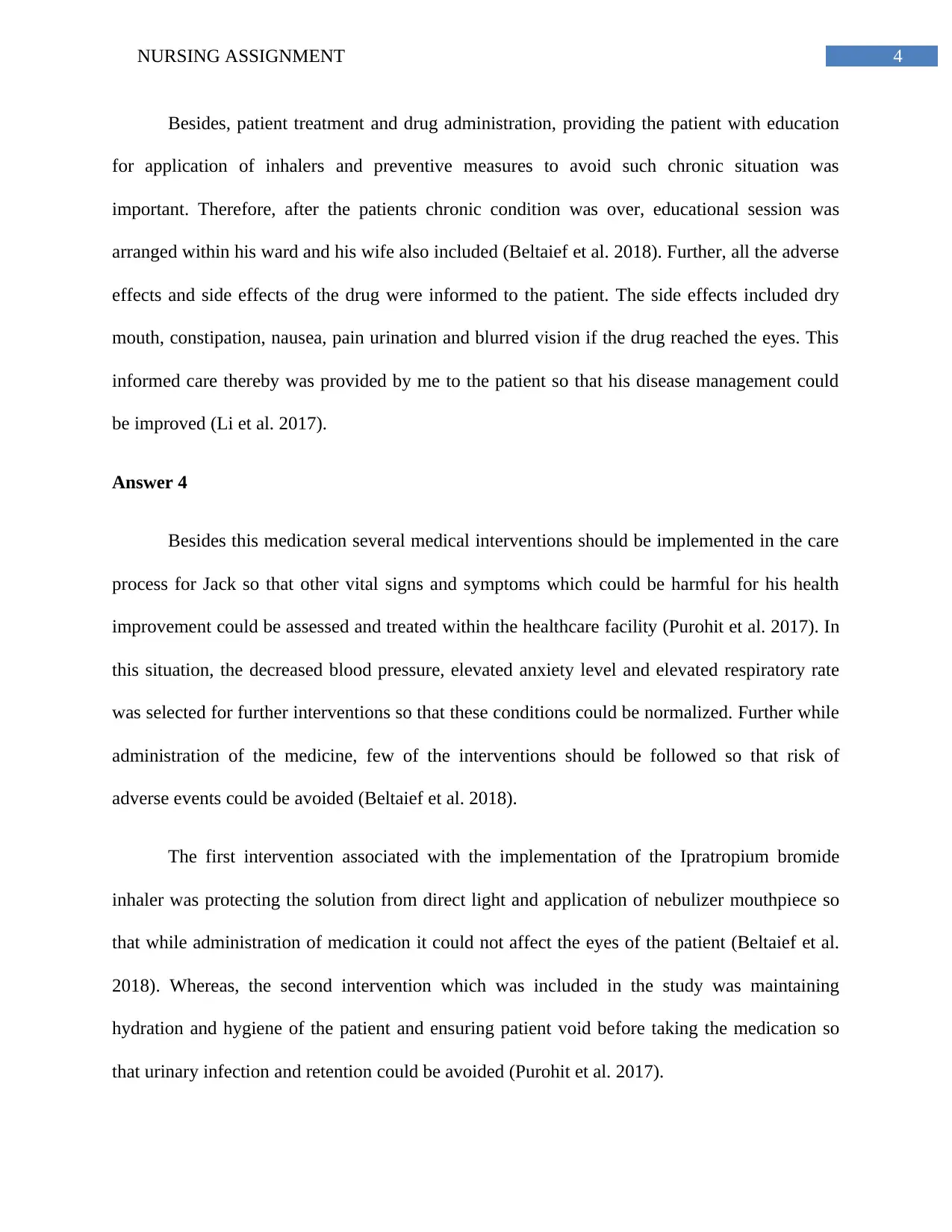
4NURSING ASSIGNMENT
Besides, patient treatment and drug administration, providing the patient with education
for application of inhalers and preventive measures to avoid such chronic situation was
important. Therefore, after the patients chronic condition was over, educational session was
arranged within his ward and his wife also included (Beltaief et al. 2018). Further, all the adverse
effects and side effects of the drug were informed to the patient. The side effects included dry
mouth, constipation, nausea, pain urination and blurred vision if the drug reached the eyes. This
informed care thereby was provided by me to the patient so that his disease management could
be improved (Li et al. 2017).
Answer 4
Besides this medication several medical interventions should be implemented in the care
process for Jack so that other vital signs and symptoms which could be harmful for his health
improvement could be assessed and treated within the healthcare facility (Purohit et al. 2017). In
this situation, the decreased blood pressure, elevated anxiety level and elevated respiratory rate
was selected for further interventions so that these conditions could be normalized. Further while
administration of the medicine, few of the interventions should be followed so that risk of
adverse events could be avoided (Beltaief et al. 2018).
The first intervention associated with the implementation of the Ipratropium bromide
inhaler was protecting the solution from direct light and application of nebulizer mouthpiece so
that while administration of medication it could not affect the eyes of the patient (Beltaief et al.
2018). Whereas, the second intervention which was included in the study was maintaining
hydration and hygiene of the patient and ensuring patient void before taking the medication so
that urinary infection and retention could be avoided (Purohit et al. 2017).
Besides, patient treatment and drug administration, providing the patient with education
for application of inhalers and preventive measures to avoid such chronic situation was
important. Therefore, after the patients chronic condition was over, educational session was
arranged within his ward and his wife also included (Beltaief et al. 2018). Further, all the adverse
effects and side effects of the drug were informed to the patient. The side effects included dry
mouth, constipation, nausea, pain urination and blurred vision if the drug reached the eyes. This
informed care thereby was provided by me to the patient so that his disease management could
be improved (Li et al. 2017).
Answer 4
Besides this medication several medical interventions should be implemented in the care
process for Jack so that other vital signs and symptoms which could be harmful for his health
improvement could be assessed and treated within the healthcare facility (Purohit et al. 2017). In
this situation, the decreased blood pressure, elevated anxiety level and elevated respiratory rate
was selected for further interventions so that these conditions could be normalized. Further while
administration of the medicine, few of the interventions should be followed so that risk of
adverse events could be avoided (Beltaief et al. 2018).
The first intervention associated with the implementation of the Ipratropium bromide
inhaler was protecting the solution from direct light and application of nebulizer mouthpiece so
that while administration of medication it could not affect the eyes of the patient (Beltaief et al.
2018). Whereas, the second intervention which was included in the study was maintaining
hydration and hygiene of the patient and ensuring patient void before taking the medication so
that urinary infection and retention could be avoided (Purohit et al. 2017).
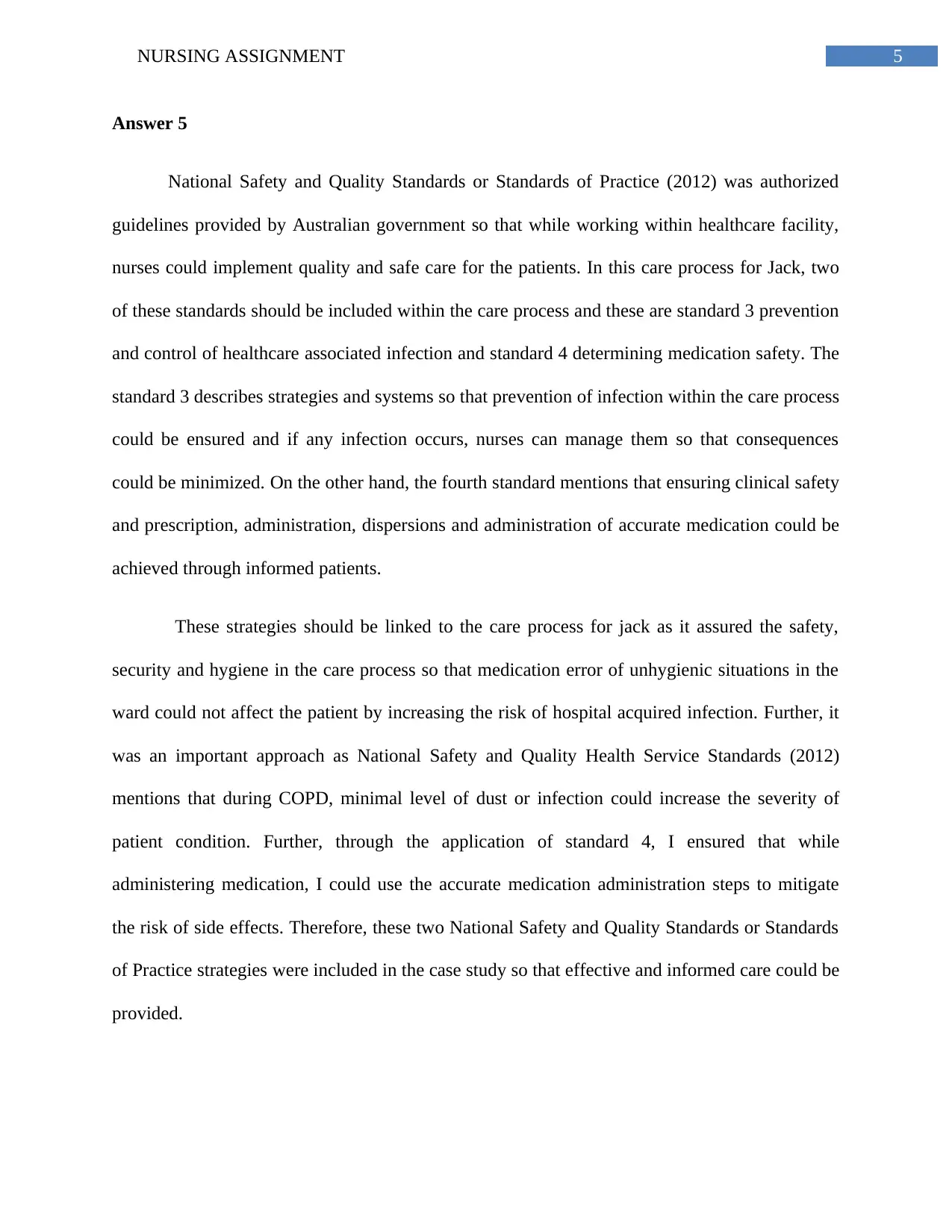
5NURSING ASSIGNMENT
Answer 5
National Safety and Quality Standards or Standards of Practice (2012) was authorized
guidelines provided by Australian government so that while working within healthcare facility,
nurses could implement quality and safe care for the patients. In this care process for Jack, two
of these standards should be included within the care process and these are standard 3 prevention
and control of healthcare associated infection and standard 4 determining medication safety. The
standard 3 describes strategies and systems so that prevention of infection within the care process
could be ensured and if any infection occurs, nurses can manage them so that consequences
could be minimized. On the other hand, the fourth standard mentions that ensuring clinical safety
and prescription, administration, dispersions and administration of accurate medication could be
achieved through informed patients.
These strategies should be linked to the care process for jack as it assured the safety,
security and hygiene in the care process so that medication error of unhygienic situations in the
ward could not affect the patient by increasing the risk of hospital acquired infection. Further, it
was an important approach as National Safety and Quality Health Service Standards (2012)
mentions that during COPD, minimal level of dust or infection could increase the severity of
patient condition. Further, through the application of standard 4, I ensured that while
administering medication, I could use the accurate medication administration steps to mitigate
the risk of side effects. Therefore, these two National Safety and Quality Standards or Standards
of Practice strategies were included in the case study so that effective and informed care could be
provided.
Answer 5
National Safety and Quality Standards or Standards of Practice (2012) was authorized
guidelines provided by Australian government so that while working within healthcare facility,
nurses could implement quality and safe care for the patients. In this care process for Jack, two
of these standards should be included within the care process and these are standard 3 prevention
and control of healthcare associated infection and standard 4 determining medication safety. The
standard 3 describes strategies and systems so that prevention of infection within the care process
could be ensured and if any infection occurs, nurses can manage them so that consequences
could be minimized. On the other hand, the fourth standard mentions that ensuring clinical safety
and prescription, administration, dispersions and administration of accurate medication could be
achieved through informed patients.
These strategies should be linked to the care process for jack as it assured the safety,
security and hygiene in the care process so that medication error of unhygienic situations in the
ward could not affect the patient by increasing the risk of hospital acquired infection. Further, it
was an important approach as National Safety and Quality Health Service Standards (2012)
mentions that during COPD, minimal level of dust or infection could increase the severity of
patient condition. Further, through the application of standard 4, I ensured that while
administering medication, I could use the accurate medication administration steps to mitigate
the risk of side effects. Therefore, these two National Safety and Quality Standards or Standards
of Practice strategies were included in the case study so that effective and informed care could be
provided.
⊘ This is a preview!⊘
Do you want full access?
Subscribe today to unlock all pages.

Trusted by 1+ million students worldwide
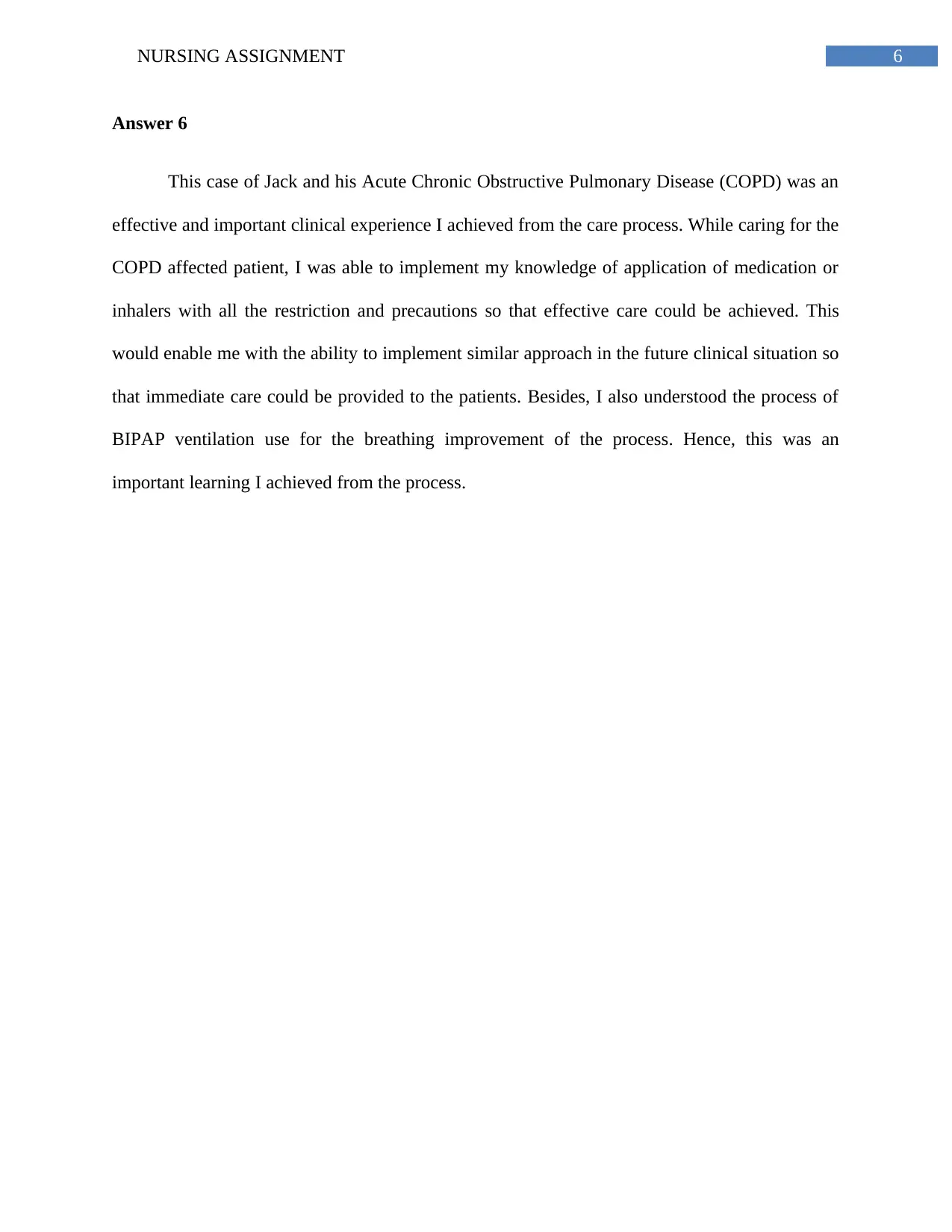
6NURSING ASSIGNMENT
Answer 6
This case of Jack and his Acute Chronic Obstructive Pulmonary Disease (COPD) was an
effective and important clinical experience I achieved from the care process. While caring for the
COPD affected patient, I was able to implement my knowledge of application of medication or
inhalers with all the restriction and precautions so that effective care could be achieved. This
would enable me with the ability to implement similar approach in the future clinical situation so
that immediate care could be provided to the patients. Besides, I also understood the process of
BIPAP ventilation use for the breathing improvement of the process. Hence, this was an
important learning I achieved from the process.
Answer 6
This case of Jack and his Acute Chronic Obstructive Pulmonary Disease (COPD) was an
effective and important clinical experience I achieved from the care process. While caring for the
COPD affected patient, I was able to implement my knowledge of application of medication or
inhalers with all the restriction and precautions so that effective care could be achieved. This
would enable me with the ability to implement similar approach in the future clinical situation so
that immediate care could be provided to the patients. Besides, I also understood the process of
BIPAP ventilation use for the breathing improvement of the process. Hence, this was an
important learning I achieved from the process.
Paraphrase This Document
Need a fresh take? Get an instant paraphrase of this document with our AI Paraphraser
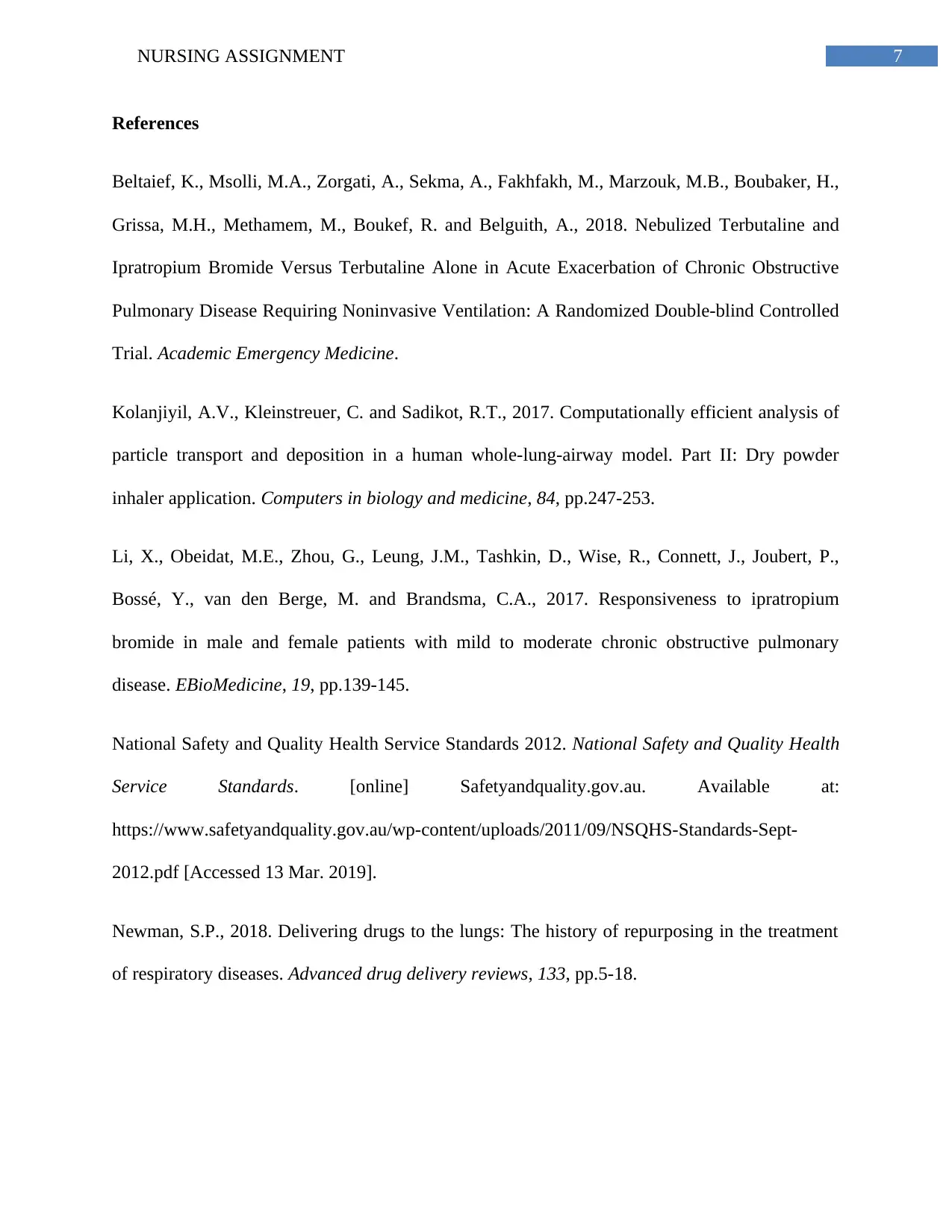
7NURSING ASSIGNMENT
References
Beltaief, K., Msolli, M.A., Zorgati, A., Sekma, A., Fakhfakh, M., Marzouk, M.B., Boubaker, H.,
Grissa, M.H., Methamem, M., Boukef, R. and Belguith, A., 2018. Nebulized Terbutaline and
Ipratropium Bromide Versus Terbutaline Alone in Acute Exacerbation of Chronic Obstructive
Pulmonary Disease Requiring Noninvasive Ventilation: A Randomized Double‐blind Controlled
Trial. Academic Emergency Medicine.
Kolanjiyil, A.V., Kleinstreuer, C. and Sadikot, R.T., 2017. Computationally efficient analysis of
particle transport and deposition in a human whole-lung-airway model. Part II: Dry powder
inhaler application. Computers in biology and medicine, 84, pp.247-253.
Li, X., Obeidat, M.E., Zhou, G., Leung, J.M., Tashkin, D., Wise, R., Connett, J., Joubert, P.,
Bossé, Y., van den Berge, M. and Brandsma, C.A., 2017. Responsiveness to ipratropium
bromide in male and female patients with mild to moderate chronic obstructive pulmonary
disease. EBioMedicine, 19, pp.139-145.
National Safety and Quality Health Service Standards 2012. National Safety and Quality Health
Service Standards. [online] Safetyandquality.gov.au. Available at:
https://www.safetyandquality.gov.au/wp-content/uploads/2011/09/NSQHS-Standards-Sept-
2012.pdf [Accessed 13 Mar. 2019].
Newman, S.P., 2018. Delivering drugs to the lungs: The history of repurposing in the treatment
of respiratory diseases. Advanced drug delivery reviews, 133, pp.5-18.
References
Beltaief, K., Msolli, M.A., Zorgati, A., Sekma, A., Fakhfakh, M., Marzouk, M.B., Boubaker, H.,
Grissa, M.H., Methamem, M., Boukef, R. and Belguith, A., 2018. Nebulized Terbutaline and
Ipratropium Bromide Versus Terbutaline Alone in Acute Exacerbation of Chronic Obstructive
Pulmonary Disease Requiring Noninvasive Ventilation: A Randomized Double‐blind Controlled
Trial. Academic Emergency Medicine.
Kolanjiyil, A.V., Kleinstreuer, C. and Sadikot, R.T., 2017. Computationally efficient analysis of
particle transport and deposition in a human whole-lung-airway model. Part II: Dry powder
inhaler application. Computers in biology and medicine, 84, pp.247-253.
Li, X., Obeidat, M.E., Zhou, G., Leung, J.M., Tashkin, D., Wise, R., Connett, J., Joubert, P.,
Bossé, Y., van den Berge, M. and Brandsma, C.A., 2017. Responsiveness to ipratropium
bromide in male and female patients with mild to moderate chronic obstructive pulmonary
disease. EBioMedicine, 19, pp.139-145.
National Safety and Quality Health Service Standards 2012. National Safety and Quality Health
Service Standards. [online] Safetyandquality.gov.au. Available at:
https://www.safetyandquality.gov.au/wp-content/uploads/2011/09/NSQHS-Standards-Sept-
2012.pdf [Accessed 13 Mar. 2019].
Newman, S.P., 2018. Delivering drugs to the lungs: The history of repurposing in the treatment
of respiratory diseases. Advanced drug delivery reviews, 133, pp.5-18.

8NURSING ASSIGNMENT
Purohit, A.N., Patel, P.P., Gandhi, A.M. and Desai, M.K., 2017. An evaluation of impact of
educational interventions on the technique of use of metered-dose inhaler by patients. Indian
journal of pharmacology, 49(2), p.194.
Purohit, A.N., Patel, P.P., Gandhi, A.M. and Desai, M.K., 2017. An evaluation of impact of
educational interventions on the technique of use of metered-dose inhaler by patients. Indian
journal of pharmacology, 49(2), p.194.
⊘ This is a preview!⊘
Do you want full access?
Subscribe today to unlock all pages.

Trusted by 1+ million students worldwide
1 out of 9
Related Documents
Your All-in-One AI-Powered Toolkit for Academic Success.
+13062052269
info@desklib.com
Available 24*7 on WhatsApp / Email
![[object Object]](/_next/static/media/star-bottom.7253800d.svg)
Unlock your academic potential
Copyright © 2020–2025 A2Z Services. All Rights Reserved. Developed and managed by ZUCOL.





